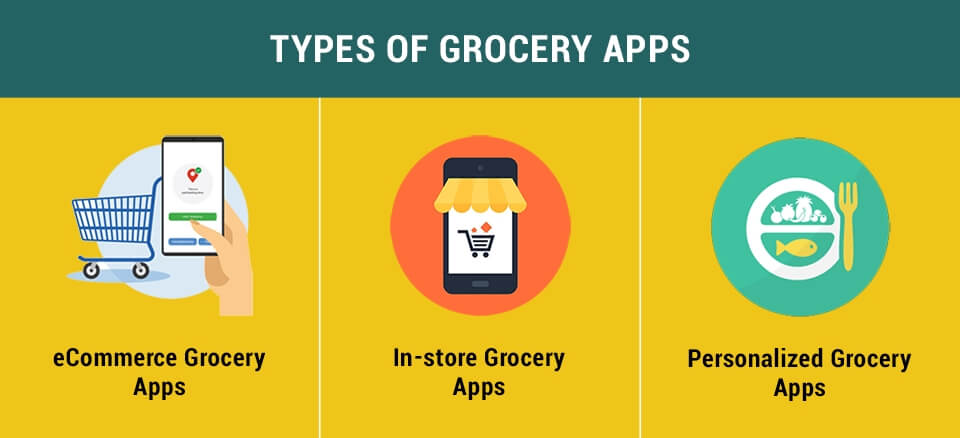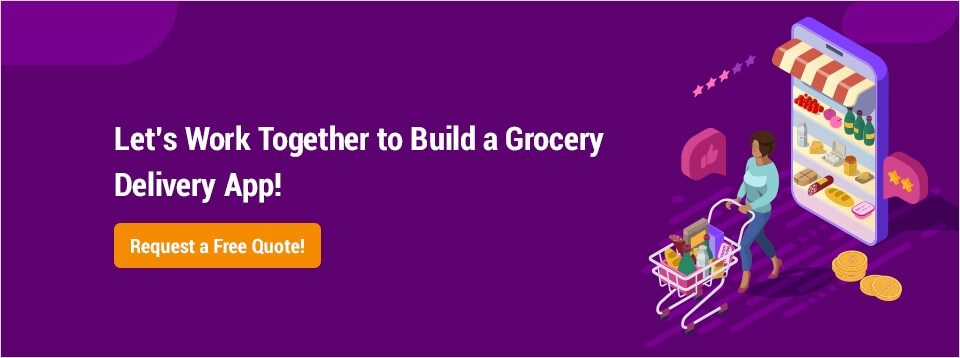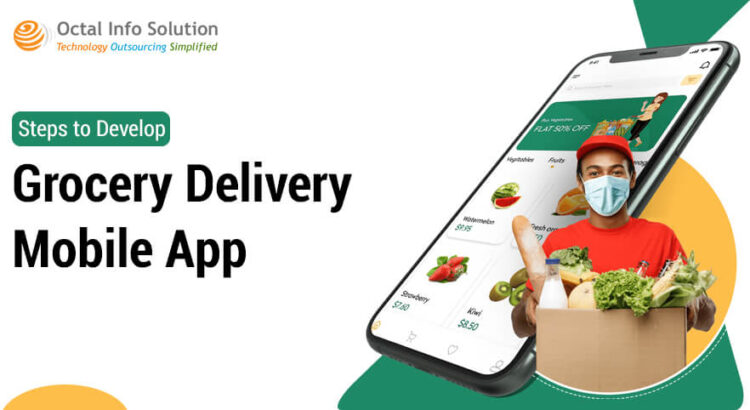The grocery industry is extensive, growing by a CAGR of 18% to reach $19B revenue in 2019. By 2021, from estimation, at least 50% of online customers buy items once a week from an online source. Economic growth has fueled the increasing number of consumers, which drives a high range of global grocery prices in developing countries like India and China.
In June 2019, Amazon entered the market of Whole Food and Groceries to enhance the experience of fresh groceries at the home. It has inspired many feature intrinsic factors in the online solutions to build trust amongst their customers. In November 2020, Amazon India Pvt. Ltd began their grocery delivery app solution in the new Amazon Store outlets in different cities like Ahmedabad, Pune, Kolkata, and Chennai. They have expanded their market with the specialized geographical network inscribed with ultra-fast delivery options and daily essentials.
Other market leaders like Walmart and Kroger Co. have updated their fast delivery options for online platforms. Such kinds of initiatives prove to be helpful in buying behavior of consumers.
Some of the outstanding players in the Indian online grocery delivery market are:
- Godrej Nature’s Basket Ltd.
- Grofers India Pvt. Ltd.
- PayTM E-Commerce Pvt. Ltd. (PayTM Mall)
- Reliance Retail Ltd. (Reliance Fresh)
- Spencer’s Retail
- Supermarket Grocery Supplies Pvt. Ltd. (BigBasket)
- UrDoorstep eRetail Pvt. Ltd.
Why Build a Grocery Delivery App?
Current pandemic situations have made it a necessity for everyone to avoid going outside. Thanks to the availability of many mobile app solutions, it makes our life much easier. Businesses have to delve into the need of this time and come up with new solutions to help ease the lives of many.
Grocery delivery application development helps reduce the wastage of external goods, supporting small-scale grocers as they are the valuable source of maintaining the chain of grocery delivery app solutions. With the use of grocery apps, quick delivery at your doorsteps is possible.
Types of grocery delivery apps

Depending upon many factors, grocery mobile apps are classified into three types:
-
eCommerce Grocery Apps
This type of eCommerce application makes it easy for users to buy groceries regardless of their location. It allows them to select delivery timings as per their comfort and amenity. Online retailers who prefer delivery services find such apps extremely useful.
-
In-store Grocery Apps
Powered by the Augmented Reality & Virtual Reality, such kinds of grocery apps do a brilliant job of displaying various grocery products with descriptions of each one of them. They virtually reconstruct the actual view of the store and this way provides a basic concept to users about grocery products’ quality.
-
Personalized Grocery Apps
These apps make the task of grocery shopping extremely easy for users. It allows the customers to prepare a grocery list, share it with the store and then they can accordingly set items they want to purchase. The products can be availed by the users whenever they need them.
Grocery Delivery Application Development Challenges
To mark an impact in the business comes with many challenges beforehand. While proceeding further with the journey of grocery delivery app development, let’s understand the considerable challenges physical stores would have.
Arrangement of Large storage with sustainable costs:
The allocation of large groceries into physical storage caused a lot of cost to the business. They have to focus on maintaining the equilibrium with this aspect, which is easily possible by turning the entire store online. Integrate the stores with just-in-time inventory management systems to save your extra bucks and reduce the extra wastage and headaches.
Difficult to target smaller areas:
There are very few means of convenience for the smaller markets. People in rural areas are habitual of buying their kitchen items from the nearby stores they trust. They deny any megastores or online platforms to look after for their daily bread. So it’s very difficult to search online markets in smaller areas.
Good customer loyalty is again a challenge:
In this tough competitive world, increasing your business and maintaining customer loyalty every time is a tough nut to crack. Many competitors are in the market, making it a possibility every time that your customers will switch to other online options.
Therefore, it is required to analyze your challenges before starting a grocery mobile app development project.
Business Models

If you want to satisfy the user’s needs and launch an online market for grocery supply operation, then understand a few business models which can be useful for your venture.
Inventory Model:
Get the direct supply of needs from the vendors. This is a niche-based model, maintaining the proper liable consistency of the products.
Multi-Vendor Marketplace Model:
In this model, you can easily tie up to any of the local stores and allow them to list their products on your online platform and mark a commission for every sale of groceries at a good rate. Amazon is the best example of a multi-seller model.
Shopping Model:
This model is very similar to the multi-seller model, except for the fact that customers need not to choose their items from a store. This model has its network of distributors for delivering supplies to their customers. Swiggy runs its business on the same model.
These are the main business models you can follow with your grocery delivery mobile application. There are some other models too, like a hyper-local model and online selling model, to allow multiple features to their application interface and facilitate their customers with optimized grocery app development cost and time.
Features /Panels for Grocery Mobile App
The app comes with different panels for different parties. In a simple application, we consider three types of users, namely the Admin, the Store Owner/Supplier, and the Customer. Below are the features each of the user panels consist of.

Customer Panel:
User Profile: Coming to the login & registration part, the approach is quite flexible. Users can sign in to the app with their email ID, Facebook ID, or by entering OTP received on their mobile number.
Browse Products: It enables picking specific products from the list of grocery and food products enlisted with a complete description.
Search for Products: Users can easily recognize the products they are looking for. They just need to apply the right filters for sorting the products appropriately.
Schedule Delivery: A specific time framework can be chosen by the users during which they desire to receive their orders.
Order Tracking: This feature makes it easy for the customers to be informed regarding the status and location of their order by offering real-time tracking information.
Order Management: With the help of this feature, users can place orders quite conveniently. Shoppers can view their past orders; accordingly, the same orders can be placed by them whenever needed.
Multiple Payment options: Users can make payments conveniently and securely with various payment integration modes being available to them.
Offers & Discounts: Here in this section, customers can gather all information regarding deals, offers, and discounts they seek to avail for themselves.
Feedback & Ratings: Users can head here to rate their experience while shopping and can give reviews that can prove to be helpful for other users as well.
Grocery Store Panel:
Get notified: Here in this section you will find the requests made for deliveries along with order numbers and other details required for the processing.
Inventory Management: Items and products which are sold & received on a daily or say weekly basis, can be easily managed. Besides, the orders can be tracked, both of which are in the process of being delivered or have been delivered already.
Accept or Reject Orders: The orders can be accepted or rejected as per the availability of products, and drivers’ for accomplishing pending deliveries.
Manage Payments: With the availability of various payment gateways & other solutions, it gets possible to manage payments received as the orders are confirmed.
Manage Feedback: Look through the feedback given by the customers in regards to the products & services which are delivered to them. Going by this feedback it gets easy to improve the services, as per the client’s recommendation.
Automate your delivery requests: This feature enables drivers to accept or cancel requests if the users’ location is too far away, as delivery will exceed the stipulated time.
GPS-enabled: Driver can easily riddle out the best possible path to reach at shopper’s location in the meantime.
Calling app feature: Drivers can communicate with customers within the app to fix the delivery time and find the adequate route and location of users.
On-Time Status of Delivery: This is the crucial feature, to get quick status of assigned delivery from the user’s end.
Customer Support: It is easy answering client’s queries while also managing other activities of the store side by side. Communicating with your customers is a good way to motivate them to avail of your services in the future as well.
Admin Panel:
Dashboard: From this section, all orders & other activities can be managed and tracked, hence it makes the grocery business smooth and secure.
Manage Stores: Restaurants with multiple chains find this feature extremely useful. It allows them to manage all orders and huge number of customers altogether while being at a single location.
Assign Managers: With this feature, one can make sure that all functions of the grocery store execute smoothly. The restaurant managers can be added here to deliver an excellent customer experience.
Assign Orders: It is one feature that enables managers to assign fresh orders to grocery stores while also ensuring that every order is executed smoothly.
Manage Customers: This section enables Grocery owners to witness the app users and also coordinate with them regarding their orders.
Manage Payment: As multiple payment options are offered to the customers, so under this section, the payment modes are managed transparently.
Delivery Request Notification: Here in this section you will find the requests made for deliveries along with order numbers and other details required for the processing.
Accept or Reject Delivery Request: This feature enables drivers to accept or cancel requests if the users’ location is too far away, as delivery will exceed the stipulated timeline.
Track Customer Location on Map: Here the driver can check the location of a shopper so to find out the best-optimized path, to deliver products within the stipulated timeline.
In-app Chat & Calling feature: Drivers can communicate with customers within the app to fix the delivery time and find the adequate route and location of users.
Get Delivery Confirmation: Drivers can update the status of assigned delivery so that the delivery confirmation can be updated by the users and from the stores’ end.
Advance Features:
Real-time Analytics: Real-time analytics is an apt way to extract processed information out of an abundance of data that is stored in the app’s database. This way, grocery store owners can check the associated statistics related to the orders registered, to streamline the business operations.
Push Notifications: Boost user interaction with the app and enhance your business visibility by integrating push technology. It is a great medium to notify users regarding new grocery products & services. Further, they can be kept attuned regarding the delivery of products as well.
Communication Channels (SMS, Emails, Chat): Both drivers and users need a transparent platform to communicate so that they can share details like expected arrival timing, delays, nearby landmarks, delivery address, and everything related to the order. In-App messaging and phone calls are the best way to boost this kind of communication.
Database Design: To make the app stand out, the latest technologies like PostgreSQL, Cassandra can be implemented by the app developers. This ensures a strong back-end infrastructure. Meanwhile, for frameworks, it is advised to go with the likes of JavaScript and Python.
Further, for robust and impactful back-end development, the following tools & technologies can be incorporated:
Kafka Software: To manage data in real-time
Amazon S3: To store and cache
GraphWalker: To integrate the Python services and is helpful in model-based testing
Google Cloud Platform: To develop primary platform structure
NginX: Easy & most effective open-source to implement on proxy servers.
As the back-end is developed, ensure that the selection of the database structure and design is done astutely. It is quite a work to develop server-side and one must adhere to the latest technical paradigms for a supermarket shopping app development, which can run on various platforms.
GPS Tracking: GPS (Global Positioning System) is crucial in the grocery mobile app development. It gets easy for drivers to locate destinations with the help of maps. Besides, the information is updated easily in real-time to users and admin.
Google Maps: They work best for navigation as they offer customization advantages and advanced features. Besides iOS mobile apps, users can choose MapKit followed by selecting an appropriate API or SDK.
Payment Integration: Multiple payment gateways like Stripe, PayPal, Apple Pay, and Braintree can be used for payment. This boosts transparency and is hassle-free.
Technology Stack
- Real-Time Analytics – Hadoop, Spark, BigData, Apache Flink, Cisco, IBM
- Cloud Environment – AWS, Google, Azure
- Database –MailChimp Integration, MongoDB, Hbase, Cassandra, Postgres
- Payments – Braintree & PayPal, Stripe, EWallets
- SMS, Voice, and Phone Verification – Nexmo, Twilio
- Push Notifications – Twilio, Push.io
Grocery Delivery App Development Process

The grocery delivery mobile app development process comprises five stages. It is a very streamlined process that requires a comprehensive study of many things, including coding to design using pre-made templates.
- Wireframing: The initial process is the wireframing to plan a detailed idea from scratch to every level of stages. This would outline at the beginning the failures and frame the well-engaged interface.
- Designing: In the next process, designers begin to process their ideas and label a layout for structure. Designing is perhaps the most important of all, since the visual appeal plays a crucial role in attracting the customers and keeping them engaged with the application.
- Prototyping: Prototyping is the must-have stage to avoid any expensive reworking in the future product.
- Development/Programming: This is the step where the real application comes alive. Based upon the operating system you want to leverage to and the features you want to integrate, you may need an eCommerce Development Services Provider that understands your requirement properly and execute it well.
- Quality Testing: The final process is the testing stage to check the functionality and grocery delivery app cost to make sure it works properly.
Team Requirement:
Well, a professional team is the must-have for developing an online grocery mobile app from scratch, which would be scalable and responsive. The right team consists of several members in it – as listed below:
- Project Manager
- Graphic Designers
- Android and/or iOS Developers
- Front-End (UI/UX, Angular) and Back-End Developers (PHP Developers, .NET Developers, Node JS Developer)
- Business Analyst
- Quality Analyst
Cost of Grocery Delivery App Development:
The team to develop a grocery mobile app consists of proficient project manager, developers, designers, and testers. It is vital to find the grocery delivery app development company with the right skill-set to develop a great app. Now, the cost to develop such a mobile app can be evaluated based on three key factors, which consist of the Complexity of the App, the number of dedicated platforms an app requires, and the region, as every country has its budget ratios.

- South East Asia-based developers: $10-$80 per hour
- U.S.A. based developers: $50-$250 per hour
- Eastern-Europe based developers: $30-$150 per hour
Calculating the overhead costs, an average grocery app should cost you around $20k to $ 70k. Now, if you choose to develop a cross-platform app or want to add more features, then the cost may rise up to $150k. However, spending that amount on the app’s features surely guarantees success.
Conclusion
Octal IT Solution is a leading grocery delivery app development company with over a dozen successful applications already distributed for this niche. The company has been appreciated as one of the best mobile app solution providers in the industry for over 14 years. We are here with a team of experts to deliver an array of solutions to various clients. The cost of grocery app development isn’t much which guarantees high ROI as compared to other initiatives. So, if you are planning to dive into this global app market then, connect with us without any delay.

















